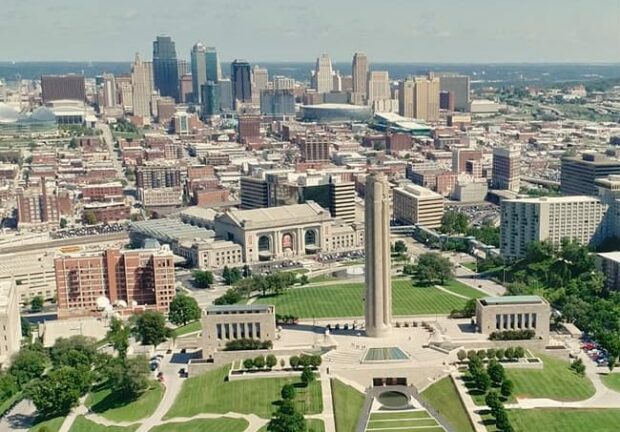HOME | ABOUT US | MEDIA KIT | CONTACT US | INQUIRE
HOME | ABOUT US | MEDIA KIT | CONTACT US | INQUIRE
With the new KCI virtually in place, the region is ready to take off, construction executives say.

Kansas City is about to open a new front door to the world, with the single-terminal configuration of its new international airport officially just weeks away. Unofficially, the construction at KCI is done, project executives said this month; now it’s a matter of finishing up some key details. That work should be done before thousands of visitors descend on this region—and pressure-test the capacity of KCI to match its predecessor’s famed ease of access and escape. At that point, construction executives say, Kansas City’s ticket will be punched for a years-long flight of growth and exposure to the world.
Consider: even before the NFL draft starts on April 27, two transformational construction projects are already moving dirt: The massive Panasonic Energy battery plant in De Soto, which will employ 4,000 people when it opens in 2025 at an estimated cost of $4 billion. In the Northland, Facebook’s parent, Meta, is moving forward with the first part of a sprawling 900-acre data-center campus, a project with a decades-long buildout schedule that could generate $100 billion in investment. Yes, with a “b.”
Each of those, in turn, is expected to produce equivalent investment in projects that provide retail, office, residential, and infrastructure support for the main efforts. That’s especially true for Johnson County: the Panasonic plant will occupy but a fraction of the 9,000-acre site that was once home to the Sunflower Army Ammunition Plant. The new factory is expected to pull in additional manufacturing with Panasonic vendors and create additional momentum for a decade-long buildup of the region’s warehousing and distribution centers.
Then factor in the continuing expansion of the Downtown streetcar line between the River Market at UMKC (cost: $254 million), the potential for a new baseball stadium Downtown (estimated cost: $2 billion, including surrounding-area development), and the incalculable economic benefits of being a FIFA World Cup host city in 2026—well, let’s just say there’s a lot on the civic agenda for several years to come.
So if a national recession is in the offing, there’s reason to hope that the Kansas City region isn’t on its itinerary. For some companies, participation in any downturn will be purely optional.
Those are just a few reasons why construction-sector executives are optimistic about the near-term prospects in this region.
And for Rosie Privitera Biondo of Mark One Electric, there may be even more to celebrate. A proposal to put a cap over Interstate 670 Downtown could not only create enough space to accommodate a new home for the Royals, she said; it could infuse Downtown with enough vibrancy and transactional volume “to wipe out the Cordish subsidy the city is paying, and that could free up $25 million a year.” As a region, says JE Dunn’s Darcy Stewart, “we’ve got to be prepared. We really are in uncharted territory.”
As for other development, Erica Jones of MCC Corp pointed back to the airport and the aftermath of the construction work. For years, civic and business leaders have complained that the out-dated design of KCI provided a poor first impression for visitors. In fact, it was one reason Starbucks declined to bring 1,000 jobs to the region with a new office project, civic leaders say.
That barrier to business recruitment is about to go away, Jones noted. “Just think about what the new airport will bring to us,” she said.
Agreed, said Monarch Build’s Courtney Kounkel: “What a lot of people aren’t thinking about is the visibility this will have for Kansas City.”